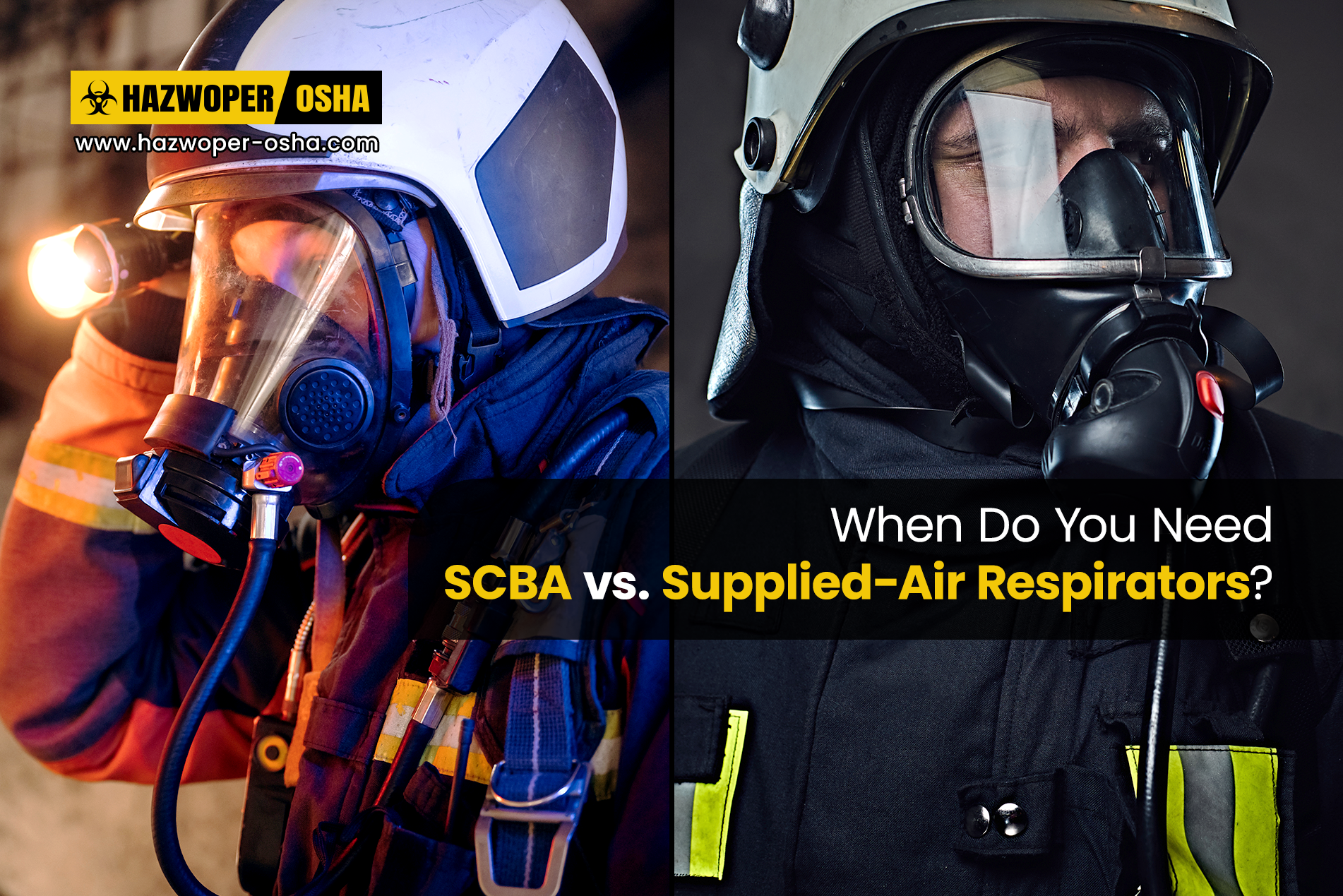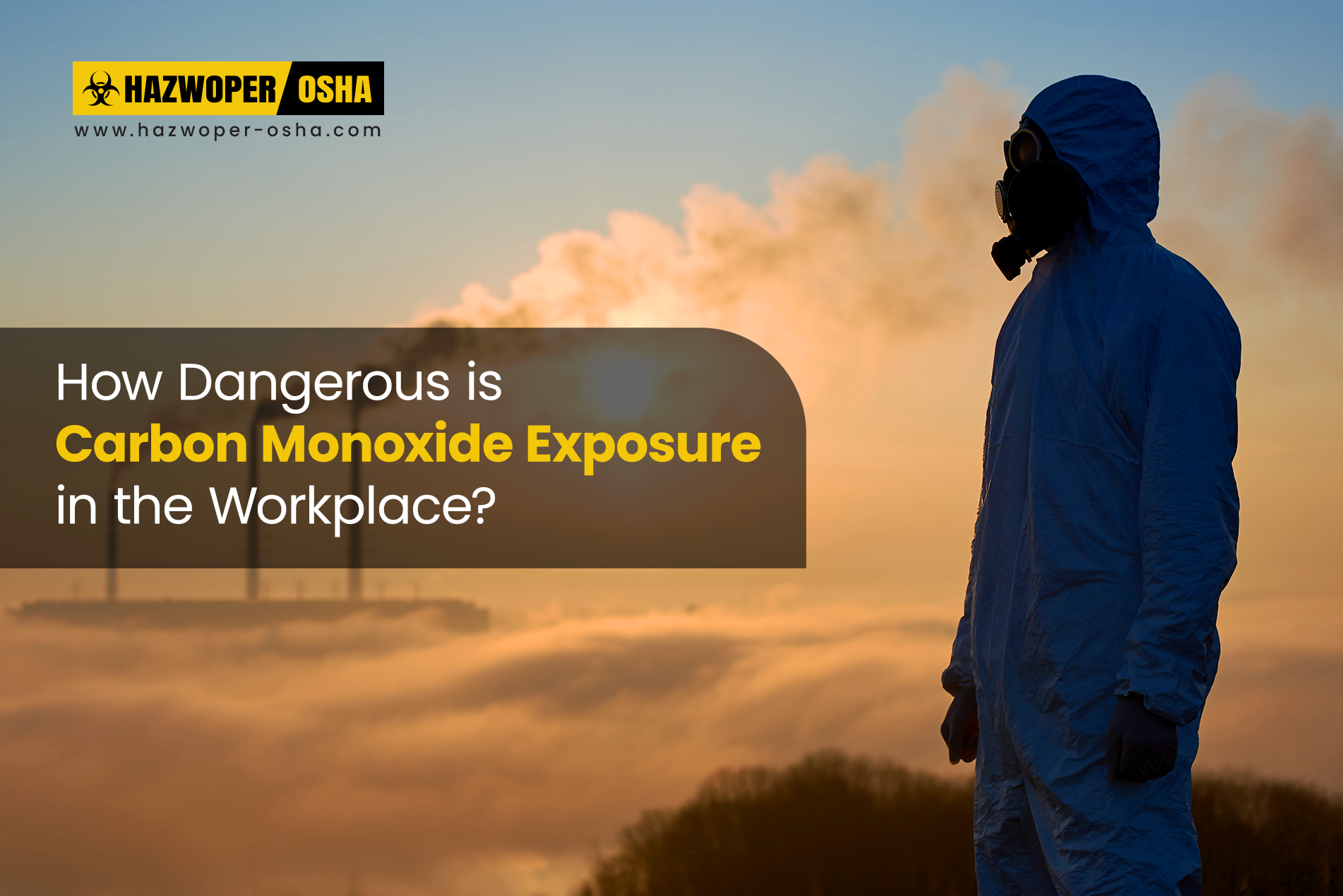The HAZWOPER 24 Hour Initial Training

The Hazardous Waste Operations and Emergency Response (HAZWOPER) is an important set of standards developed and managed by the Occupational Safety and Health Administration (OSHA). The HAZWOPER standards provide guidance for the safety and health of workers who handle HAZMAT, work with hazardous waste, and participate in emergency response and rescue operations of hazardous waste cleaning operations. This standard was enacted due to the recommendation of the Superfund Amendments Reauthorization Act (SARA) of 1986. According to the State of North Carolina Department of Labor (NCDOL), the topic of HAZWOPER covers “two critical subjects: hazardous waste site operations and emergency response to the uncontrolled release of chemicals” (n.d., para. 1).
What is Hazardous Waste?
The Code of Federal Regulations gives an all-encompassing definition of hazardous waste under its Protection of Environment regulation. Alternately, the United States Environmental Protection Agency (EPA) defines hazardous waste as “a waste with properties that make it dangerous or capable of having a harmful effect on human health or the environment” (2020, para. 2). A distinguishing characteristic of hazardous waste is its requirement for a specialist disposal methodology such as treatment or a solidification process. An example is a wastewater treatment plant which is often found in many plants and manufacturing facilities.
Hazardous waste is generated by many industries and functions, as well as manufacturing processes and even in our homes. Hazardous wastes have diverse physical states such as gaseous, liquids, or solids. Furthermore, hazardous wastes are of different categories and carry different hazard levels. As such, information on handling hazardous waste when carrying out a job task, and during the cleanup process is covered in all HAZWOPER training including the HAZWOPER 24-hour course.
What does Emergency Response mean in HAZWOPER?
The NCDOL defines “emergency response or responding to an emergency as a response effort by employees from outside the immediate release area or by other designated responders to an occurrence which results, or is likely to result, in an uncontrolled release of a hazardous substance” (n.d., para. 2). OSHA categorizes an emergency response as an “uncontrolled release of a hazardous substance, or where an uncontrolled release is likely” (n.d.a, para. 6). In case of a hazardous waste emergency, an emergency response team would be required to do everything in their power to prevent the spread of hazardous materials to limit the negative impact on the safety and health of people and biodiversity.
In the following instances, there would be no need for emergency response:
- If an accidental release of a hazardous substance or waste is controllable through either absorption or adsorption.
- If an unintentional discharge of hazardous wastes or materials can be neutralized at once after the occurrence of the incident by workers in the vicinity or maintenance personnel.
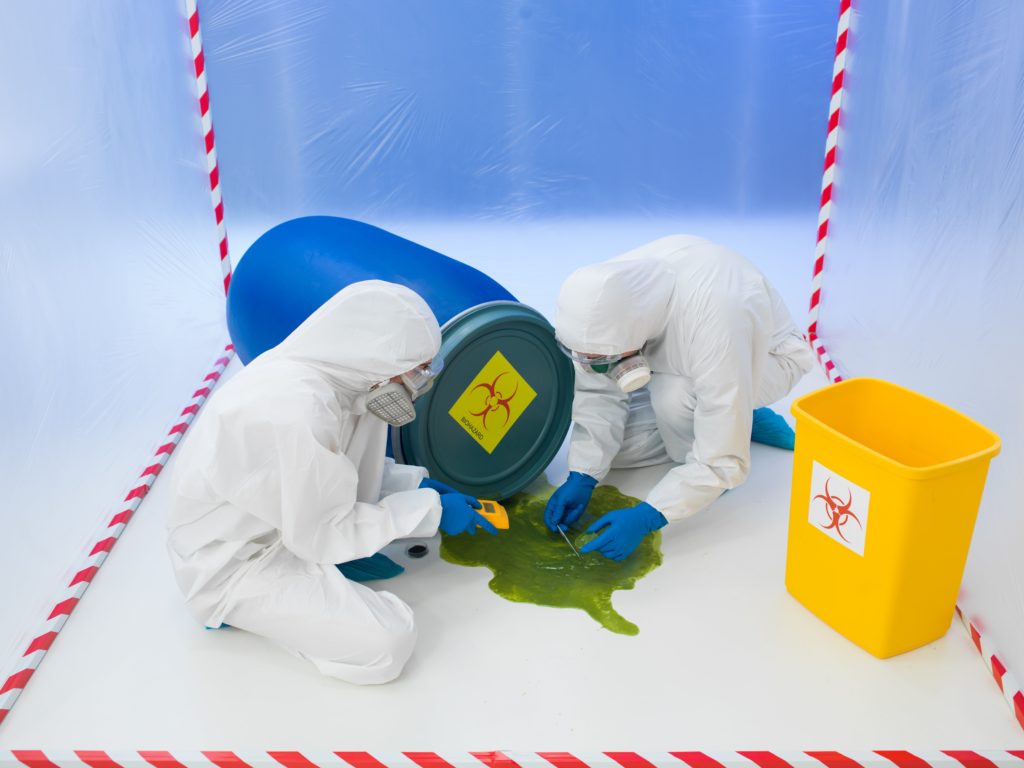
Who are HAZWOPER Workers?
So, who among the American workforce are categorized as hazardous waste and emergency response workers? As hazardous materials and waste emergencies occur in most industries, any person who works in an industry that generates hazardous waste or uses hazardous substances would be considered a HAZWOPER worker. Similarly, those individuals working in emergency response teams, and those employed by the national emergency response services considered to be HAZWOPER employees. Firefighters asked to deal with hazard-related emergencies is an example of HAZWOPER workers.
OSHA’s HAZWOPER standard covers employees working for:
- hazardous waste site cleanup operations;
- facilities involved in hazardous waste treatment, storage, and disposal (TSD) facilities; and
- emergency response operations involving hazardous substance releases. (OSHA, n.d.a)
How many HAZWOPER Standards Exist?
Both OSHA and the EPA under the authority of the Superfund have released identical HAZWOPER standards. The difference exists in its target employer groups. OSHA’s HAZWOPER standards apply to General Industry and the Construction Industry and to the 28 states which have OSHA-approved State Plans. Meanwhile, the EPA HAZWOPER standard is aimed at protecting paid and voluntary employees working for the local and state governments in states that do not operate an OSHA-approved State Plan (OSHA, n.d.).
Scope of the HAZWOPER Standard

The HAZWOPER standard covers five critical, yet distinct operations related to hazardous waste emergencies.
- The cleanup operations of hazardous substances conducted at uncontrolled hazardous waste sites that are mandated by a governmental body.
- Corrective actions involving cleanup operations at sites covered by the Resource Conservation and Recovery Act (RCRA).
- Operations involving hazardous waste conducted at treatment, storage, and disposal (TSD) facilities regulated under RCRA.
- Operations that generate hazardous waste but are not TSD facilities.
- Emergency response operations due to the release of, or substantial threat of release of hazardous substances, without regard to the location of the hazards. (OSHA, n.d.a)
Importance of HAZWOPER Training
Exposure to hazardous materials can cause many harmful health and safety problems. These range from skin irritations to chemical burns and can result in more permanent physical damage to people. Accidental release of hazardous substances in large amounts can cause explosions and fires, pollute the air with toxins, and may cause irreparable damage to the surrounding natural environment (OSHA, n.d.b). A popular example is oil spills that pollute oceans. As such, all employees who work in hazardous waste and emergency response operations must be aware of and able to react to, manage, act, control, and cleanup emergencies related to hazardous substances in the workplace. Moreover, employers must ensure worker safety from uncontrolled spills of chemical or biological toxins and other hazardous materials in the workplace. Employers are also required to facilitate the implementation of the HAZWOPER standard to worksite response and cleanup activities. By promoting continuous and diligent worker training, employers will be able to safeguard from the negative impact of hazardous releases which can cause short- or long-term harm to employees and workplace operations and assets.
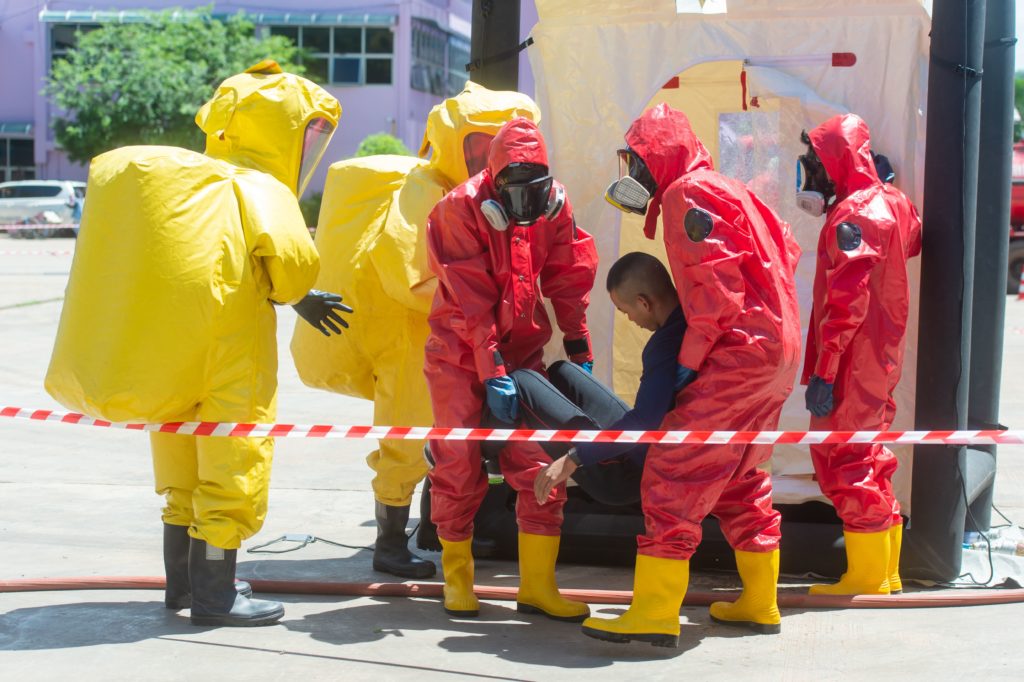
Hence, workplace safety training such as the HAZWOPER 24-hour initial training is required under the HAZWOPER standard for all employees who may be exposed to hazardous substances in a range of occupations. These occupations may range from bricklayers, electrical engineers to equipment operators, general laborers, and supervisors, or managers. Further, OSHA considers a safety and health training program for workers as a part of the site Health and Safety Plan (HASP). As such, there are 18 HAZWOPER training courses developed for the specifics of different job tasks and occupations for general site workers, workers handling hazardous waste, and for emergency response workers. One of these training programs is the preliminary HAZWOPER 24-hour training for workers before starting their jobs at HAZMAT worksites.
A snapshot of the OSHA required HAZWOPER online training courses are given below, but to learn more, read our blog on HAZWOPER Training Level – Know the Basics.
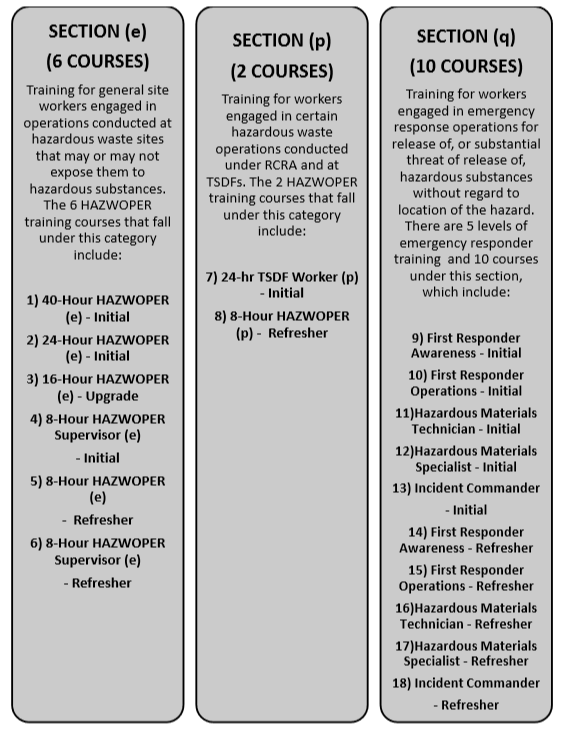
Besides, the HAZWOPER training required by OSHA covers many topics, at different intensities depending on employee occupation and tasks. The length of the HAZWOPER training also plays an important role in the breadth and depth of topics covered. While the HAZWOPER 24-hour training would not go into much detail, the HAZWOPER 40-hour training will give the trainee detailed safety and health information. An overview of topics that may be captured within the HAZWOPER 24-hour training program is given below.
- safety and health hazards present on the site;
- identification of hazards such as radioactive wastes, toxic chemicals, etc., present on the site;
- use, handling, wearing, removal, and storage of personal protective equipment such as respirators, face shields, totally encapsulating chemical protective suits, etc.;
- work practices to minimize risks from hazards;
- safe use of engineering controls, machinery, and equipment;
- medical surveillance requirements consisting of symptom recognition and signs indicating overexposure to hazards;
- proper storage of dangerous goods; and
- hazard monitoring and monitoring of high-risk employees. (OSHA, n.d.c).
Also, read the article on HAZWOPER Training: Important Things You Must Know for additional information.
Online HAZWOPER 24-Hour Training
The most critical HAZWOPER training courses are the preliminary OSHA HAZWOPER 24-hour and the OSHA HAZWOPER 40-hour training courses. Workers must undergo either of these training requirements before they can enter or begin work on an uncontrolled hazardous waste operation site. The initial HAZWOPER 24-hour training comprises both off-site instruction (online training programs) and field experience under the direct supervision of a trained, experienced supervisor. The HAZWOPER 24-hour is the minimum training requirement for general site workers such as equipment operators, general laborers, excavation specialists, and supervisory personnel engaged in hazardous waste removal or other activities that would expose or potentially expose them to hazardous substances.
The main target audience of the HAZWOPER 24-hour training which incorporates both online training and one-day actual field experience, are employees working at contaminated sites but who undertake work tasks that do not expose them to hazardous substances at or above the Permissible Exposure Limits (PELs). Below follows a comprehensive list of employees who require the HAZWOPER 24 Hour training according to OSHA’s HAZWOPER 24 Hour initial training regulation section 1910.120(e)(3).
- Workers who are at hazardous sites only occasionally for a specific limited task. Limited tasks refer to such tasks as groundwater monitoring, land surveying, or geophysical surveying. As such, these workers are expected to have limited exposure with unlikely exposure to hazardous substances over the permissible exposure limits and published exposure limits.
- Workers who are regularly on site but work in areas which have been monitored and fully characterized. This means that exposures at these sites are declared to be under permissible exposure limits and published exposure limits. There is no requirement for workers to use respirators, and the characterization indicates that there are no health hazards or the possibility of an emergency developing.
- On-site managers and supervisors directly responsible for, or who supervise employees mentioned in points one and two above. However, due to their higher-level job responsibilities, managers and supervisors are expected to obtain at least an additional eight hours of specialized training at the time of job assignment on such topics as, but not limited to, the employer's safety and health program and the associated employee training program, personal protective equipment program, spill containment program, and health hazard monitoring procedure and techniques. (OSHA, n.d.c).
While worker training is the employer’s responsibility, today, all employers and their employees have easy access to the off-site portion of the OSHA recommended HAZWOPER 24-hour training in the form of online training program providers. These training courses are developed to meet OSHA’s HAZWOPER training requirements. An added benefit of online training is access to certified trainer assistance. Also, each taker of the HAZWOPER 24-hour online training course is provided with an authorized certificate of completion on the successful conclusion of the final exam.
In Conclusion
The HAZWOPER 24-hour training is only the beginning of the HAZWOPER training journey. As an employee rises in rank and job responsibility, they would need to extend their HAZWOPER training to more than the HAZWOPER 24-hour course and also enroll in other specialized HAZWOPER training programs. However, those employees who only wish to renew their OSHA HAZWOPER 24 Hour online training course can simply take the OSHA 8 Hour HAZWOPER Refresher online training course to renew their existing HAZWOPER 24-hour training certificate.
References
North Carolina Department of Labor (NCDOL). (n.d.). Hazardous Waste Operations and Emergency Response. Hazard Overview. Retrieved from https://www.labor.nc.gov/hazardous-waste-operations-and-emergency-response#hazard-overview
OSHA. (n.d.a). Hazardous Waste Operations and Emergency Response (HAZWOPER). Background. Retrieved from https://www.osha.gov/emergency-preparedness/hazardous-waste-operations
OSHA. (n.d.a). Hazardous Waste Operations and Emergency Response (HAZWOPER). Overview. Retrieved from https://www.osha.gov/emergency-preparedness/hazardous-waste-operations
OSHA. (n.d.c). By Standard Number, 1910.120 - Hazardous waste operations and emergency response. Retrieved from https://www.osha.gov/laws-regs/regulations/standardnumber/1910/1910.120
United States Environmental Protection Agency (EPA). (2020, February 19,) Hazardous Waste. What is a Hazardous Waste? Retrieved from https://www.epa.gov/hw/learn-basics-hazardous-waste#hwid

 EN |
EN |  ES
ES























































































































